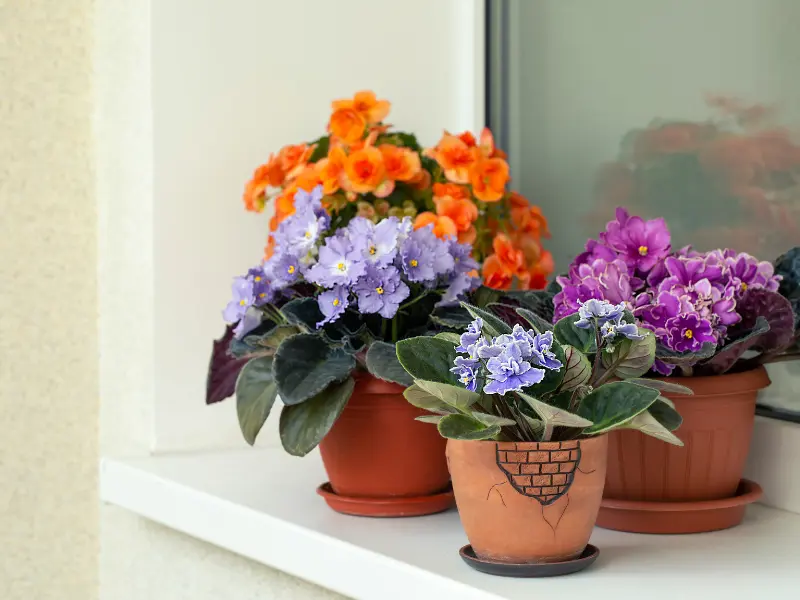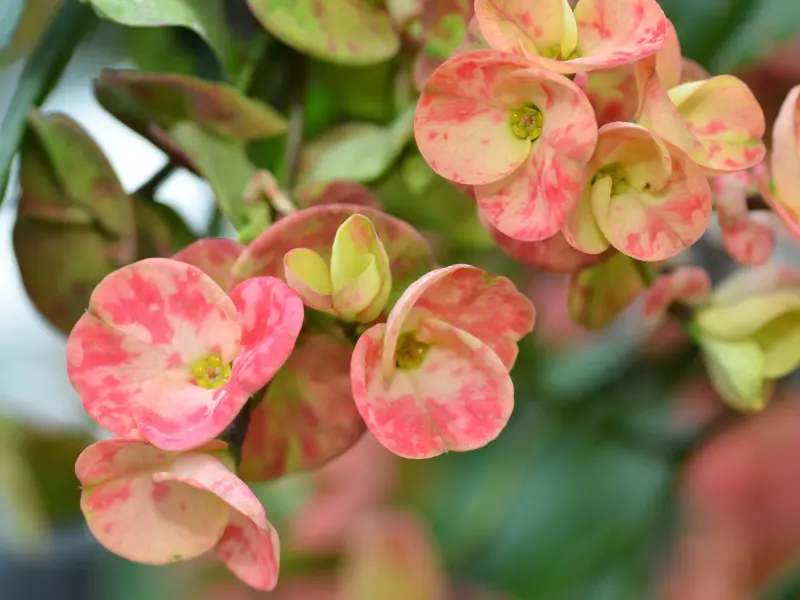Are you tired of looking at a dull living room every winter, longing for a splash of color to boost your mood and make your space feel alive? I’ve been there, and I know how frustrating it can be. That’s why I’ve gathered this list of Top Best 15 Indoor Flowering Plants to help you transform your home into a cozy, vibrant haven even when it’s freezing outside. Each one is perfect for brightening up your home in winter.
Most of these indoor flowering plants don’t need intense sunlight and can handle lower indoor humidity levels better than other tropical varieties. Many of them naturally bloom in cooler months or can be encouraged to bloom with the right conditions—perfect for those dreary winter days. Also, adding decorative potted flowers can improve mood and indoor air quality, a definite plus if you’re spending more time at home.
I’ll walk you through easy indoor gardening tips to keep them blooming. Let’s dive right in!
1. Oxalis (Shamrock Plant)

Often known as the Shamrock Plant, Oxalis boasts triangular, clover-like leaves that can be a deep purple shade or classic green, sometimes with subtle silvery patterns. These leaves fold down at night or in dim light, creating a mesmerizing ‘sleep and wake’ cycle. Above the foliage, you’ll often see delicate pink or white blooms nearly all year round, adding a touch of fairytale charm to your home. It also makes a delightful gift for St. Patrick’s Day—or anytime you want to spread a little luck.
-
Light: Indirect or bright filtered light suits them best.
-
Watering: Keep the soil consistently moist, but not waterlogged. Overwatering can rot their small, bulb-like roots.
-
Bloom Time: Oxalis often flowers in winter if conditions are right—small, pretty blossoms that really brighten a room.
-
Fun Fact: Their triangular leaves close at night and open again in the morning, which is so cool to watch!
I love Oxalis for its playful leaf movements and subtle blooms. It’s also a conversation starter when guests notice the leaves “sleeping.”
2. African Violet (Saintpaulia ionantha)
Even in low light, you can enjoy stunning blooms with an African violet, one of the most popular houseplants with flowers.This classic houseplant produces soft, fuzzy leaves topped with clusters of delicate purple, pink, or white blossoms. African violets prefer bright, indirect light and can bloom year-round with proper care. They’re cousins to cape primrose, and their velvety foliage adds a cozy touch to any windowsill. Just remember to water from the bottom or use room-temperature water to avoid spotting their leaves.

Here’s how I care for them:
-
Light: They prefer part shade to indirect sun. An east or north-facing window is ideal.
-
Watering: Let the soil dry out slightly between waterings. I always avoid getting cold water on their leaves to prevent stains.
-
Temperature: They thrive in moderate indoor temperatures (around 65–75°F). Be careful with extreme heat, as it can cause collapse.
-
Bonus Tip: They’re a perfect choice for winter because they’re not fans of scorching heat.
If you’re new to blooming houseplants, African violets are a friendly option. They’re also relatively compact, making them great decorative potted flowers in small apartments or on windowsills.
Read more: Master the Art of African Violet Care: Your Ultimate Guide
3. Cyclamen (Cyclamen persicum)

Known for its elegant, butterfly-like blooms and marbled heart-shaped leaves, Cyclamen is a stunning winter-blooming houseplant that thrives in cooler indoor temperatures. Its flowers, which come in shades of pink, red, white, and purple, rise gracefully above the foliage on slender stems, creating a delicate yet striking display. Cyclamen is perfect for brightening up a windowsill or tabletop during the colder months.
- Light: Bright, indirect light
- Water: Keep the soil evenly moist but avoid letting water sit at the base of the plant
- Temperature: Prefers cool indoor temperatures (50–65°F); too much warmth can shorten its bloom time
- Dormancy: After blooming, the plant enters a rest period—reduce watering until new growth appears
With the right care, Cyclamen can bloom for months, bringing long-lasting color and charm to your home throughout winter.
4. Anthurium (Anthurium andraeanum)

Anthurium is another stunning flowering house plant that steals the show with its vibrant red, heart-shaped spathes. Some varieties also come in red, white, or even purple. Brightening up a room with an Anthurium feels like bringing home a tiny bouquet every day. It also loves humidity, so a steamy bathroom or a spot near a humidifier keeps it happy.
-
Light: Bright, indirect light helps it bloom.
-
Humidity: This tropical beauty loves high humidity, so I place it near a humidifier or mist its leaves lightly.
-
Water: Keep the soil evenly moist but avoid soggy conditions.
-
Temperature: Anthuriums are happiest around 70–85°F, so try to keep them away from chilly drafts.
5. Holiday Cactus (Schlumbergera)
If you’re craving bright blooms right in the middle of winter, Holiday Cactus could become your favorite companion.This festive plant is famous for blooming around Thanksgiving, Christmas, or Easter, depending on the variety. Holiday Cactus forms arching stems with segments that produce bright red, pink, or white flowers. It thrives in moderate indoor temps and can even flower more than once a year if it’s content.

-
Light & Temperature: Bright, indirect light and moderate indoor temperatures (60–70°F) work best.
-
Water: Water sparingly. I keep the soil slightly damp but let the top inch dry before watering again.
-
Encouraging Blooms: Shorter days and cooler nights help trigger flowering.
6. Flowering Maple (Abutilon)
Despite the name, Flowering Maple isn’t a true maple, but its leaves resemble maple leaves and it carries bell-shaped blooms in shades of red, orange, or yellow. Flowering maple adds a cottage-garden charm indoors. It typically blooms on and off all year if it gets enough light and consistent care.
-
Light: Bright light near a window is crucial. I place mine where it can soak up morning sun.
-
Water: Keep the soil moderately moist; a quick check with your finger can prevent overwatering.
-
Feeding: A balanced fertilizer every couple of weeks helps maintain vigorous growth and continuous blooms.
7. Jasmine (Jasminum polyanthum)

Yearning for a sweet fragrance during cold months? Jasmine is a delightful winter indoor plant that offers tiny white blossoms and an amazing scent and fills an entire room with fragrance. Jasmine thrives in bright light and prefers slightly cooler temps, making winter a great time for it to show off its blossoms. The star-shaped blooms make it a delight for anyone who loves a natural perfume at home.
-
Light: Jasmine thrives in bright light. Direct sunlight for a few hours can help with blooming.
-
Humidity & Temperature: Keep the environment slightly cool (about 60°F at night) to encourage buds to form.
-
Watering: Maintain evenly moist soil but ensure good drainage.
Read more: Top 3 Key Factors for Optimal Asian Snow Jasmine Growth
The Best Guide to Growing Asian Snow Plants
8. Clivia (Clivia miniata)
This eye-catching plant features thick, dark green leaves and clusters of trumpet-shaped orange or yellow flowers. Clivia can bloom in late winter or early spring, offering a vibrant display to chase away the cold-weather blues. It prefers a cool rest period in fall to help set buds. It’s a bit more uncommon, but trust me, it’s worth searching for.

-
Light: Medium to bright, indirect light is best.
-
Water: Let the soil dry out a bit between waterings to prevent rot.
-
Dormancy: In late fall, Clivia needs a rest period with less watering and cooler temperatures to set buds for winter or early spring blooms.
9. Calamondin Orange (Citrus x microcarpa)
Yes, it’s actually a small citrus tree, but Calamondin Orange can bloom indoors and even produce tiny oranges. Talk about decorative potted flowers plus fruit!

This tiny citrus tree stands out by producing fragrant white blooms that can lead to miniature oranges. The flowers smell amazing, and the little fruits add a festive pop of color. Calamondin Orange loves a spot in bright sunlight, so make sure it’s near a south or west-facing window for best results.
-
Light: At least four to six hours of bright light a day. A sunny south or west-facing window is ideal.
-
Water: Keep the soil consistently moist but not soggy. I water mine when the top inch of soil feels dry.
-
Fertilizer: Use a citrus-specific fertilizer or any balanced formula to encourage both flowers and fruit.
10. Crown-of-Thorns (Euphorbia milii)

Despite its prickly name, Crown-of-Thorns produces small clusters of colorful, petal-like bracts that bloom year-round if conditions are right. The thick, thorny stems store water, making it a forgiving choice if you sometimes forget to water. Keep it in a sunny spot for maximum bloom potential.
-
Light: It loves bright light, even direct sun for a few hours daily.
-
Watering: Succulent-like, so allow the top half of the soil to dry before watering again.
-
Caution: The plant’s sap can be irritating. Wear gloves when handling or pruning if you have sensitive skin.
I appreciate its resilience. It’s a tough plant that keeps on blooming, making it an excellent choice if you want low-maintenance indoor flowering plants.
11. Lipstick Plant (Aeschynanthus radicans)

Named for its fun, tube-like flower buds that emerge from darker calyxes, the Lipstick Plant is a star in hanging baskets and on high shelves. It produces bursts of bold red or pink blooms that look just like tubes of lipstick peeking out. Give it moderate to bright indirect light, and it’ll reward you with frequent flowering. Watering should keep the soil slightly moist—never bone-dry—so a regular check of the topsoil will help maintain consistent moisture. High humidity or gentle misting helps its leaves stay glossy and healthy, making it an eye-catching addition to any indoor garden.
-
Light: Medium to bright, indirect sunlight.
-
Water: Keep the soil slightly moist, and don’t let it dry out completely. It can drop leaves if it’s too dry.
-
Humidity: Loves a bit of extra humidity, so a bathroom with a bright window could be a perfect spot.
I love how it adds a cascading burst of color. It’s a fun way to decorate vertical spaces in your home.
12. Geranium (Pelargonium)

Often seen outdoors, geraniums can adapt indoors if they get plenty of sunlight. Their clusters of bright blooms come in red, pink, white, and more. A sunny windowsill is key for winter flowering, and with minimal care, you’ll have cheery color even in the coldest months.
-
Light: They need plenty of direct sunlight—at least four hours a day.
-
Water: Allow the top inch of soil to dry between waterings. Overwatering is a common mistake that leads to root rot.
-
Pinching & Pruning: Regularly pinch off spent flowers and leggy growth to encourage more blooms.
13. Angel-Wing Begonia (Begoniaceae)
If you want something with speckled leaves and dangling blooms, Angel-Wing Begonia is your plant. This type of begonia stands out with unique wing-shaped leaves that often display silver spots, and it produces hanging clusters of bell-shaped blooms. Angel-Wing Begonias love bright, indirect light and consistent moisture, rewarding you with pretty flowers and striking foliage.

-
Light: Bright, indirect light helps them bloom. Avoid harsh direct sun that could scorch leaves.
-
Water: Keep the soil slightly damp but don’t let it get soggy.
-
Humidity: They appreciate higher humidity, so misting or a pebble tray can work wonders.
This blooming houseplant is a showstopper thanks to its dramatic foliage.
14. Cape Primrose (Streptocarpus)
Cousin to the African violet, Cape primrose has velvety, elongated leaves and trumpet-like flowers in a rainbow of colors, from pink to purple to white. It prefers a cooler environment and indirect light, making it perfect for winter windows. Plus, it’s pet-safe, so it’s a great choice if you have furry friends.
-
Light: An east or north window works well—aim for part shade to indirect sun.
-
Watering: Let the soil surface dry between waterings. Occasional wilting isn’t a big deal, but avoid letting water touch the leaves.
-
Heat Sensitivity: Temperatures above the upper 70s can stress the plant. It’s ideal for a cooler indoor spot in winter.
-
Pet Safety: Generally safe for pets, but always double-check if you have any doubt.
- Blooms: Often speackled with whiskers or spots, adding a painterly look
15. Kalanchoe (Kalanchoe blossfeldiana)
Last but not least, Kalanchoe is a trusty succulent that bursts into clusters of tiny, vibrant flowers in winter. Sometimes called ‘florist’s kalanchoe,’ this pretty bloomer is a trusted go-to for easy winter color. Kalanchoe opens clusters of tiny flowers in brilliant shades—think red, rose, orange, yellow, and apricot. Botanically known as Kalanchoe blossfeldiana, it’s a succulent, meaning it thrives with minimal care. Place it near a south- or east-facing window for bright light, and water sparingly, letting the soil dry out completely before each watering. You’ll probably go a week or more between waterings, which is great if you have a busy schedule. If you decide to repot, use a well-draining cactus mix. Just keep in mind that this plant is toxic to cats and dogs, so make sure it stays out of reach of curious pets.

-
Light: They do best with bright light or a bit of direct sun.
-
Water: Water sparingly—only when the top inch of soil is dry. Overwatering can cause root rot.
-
Bloom Cycle: Kalanchoe typically blooms in late winter or early spring. Once the flowers fade, it may take a rest before blooming again.
Its cheerful flowers come in red, pink, orange, yellow, and white, which can truly brighten up your home. Plus, succulents generally require less fuss, making them ideal for busy folks or beginner gardeners.
Essential Winter Care Tips for Your Indoor Flowering Plants
When caring for indoor flowering plants in winter, I focus on these crucial points:
Light and Position
- Move plants closer to windows for maximum natural light.
- Clean your windows inside and out to let in as much light as possible.
- Rotate your pots weekly for even growth.
Water Schedule
- Water requirements tend to decrease in winter. Overwatering is a top cause of plant stress.
- Check soil moisture by sticking your finger about an inch deep. If it’s still moist, wait before watering again.
Humidity Control
- Indoor heating dries out the air. I use a humidifier or place plants on a tray of pebbles with water to boost humidity.
- Misting can help, but avoid foliage that’s sensitive to water spots (like African violet leaves).
Temperature
- Keep your space at a stable temperature if possible, usually between 65–75°F.
- Avoid placing plants near drafts or heating vents.
Feeding
- Some blooming houseplants still need occasional fertilizer, but in lighter doses compared to summer.
- Follow the instructions on the label or use a dilute, balanced fertilizer once a month.
Plant Maintenance Routine
- Remove spent blooms to encourage fresh ones.
- Prune dead or yellowing leaves so the plant focuses energy on healthy growth.
- Watch for pests like aphids or spider mites, as they can still show up indoors in winter.
Final Thoughts
I know how tough it can be to stay motivated during winter when everything outside looks gray and lifeless. But trust me, nurturing a small indoor garden of blooming houseplants can lift your spirits, keep your home lively, and even contribute to better indoor air. Whether you pick a fragrant Jasmine, a classic African violet, or the bold Anthurium, you’ll discover that these indoor flowering plants are more than just decorations—they become part of your daily joy.
So go ahead, pick a favorite (or a few!) from this list of Top Best 15 Indoor Flowering Plants and give yourself a mini home makeover that’ll carry you through the colder months. If you follow the indoor gardening tips we discussed—light, watering, humidity, temperature, and a consistent plant maintenance routine—you’ll soon have a bright, blooming space that feels like a tropical escape from the winter chill.
Why not pick one or two from this list and brighten up your living space right away? With the right plant maintenance routine, you’ll find it easier than ever to keep these beauties blooming all winter long. Happy gardening!
